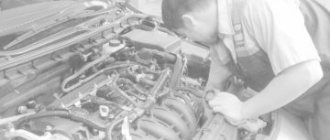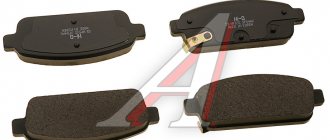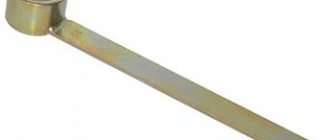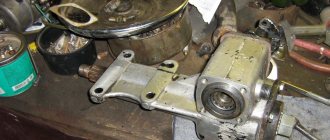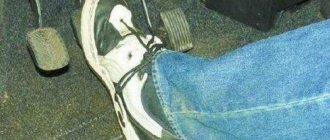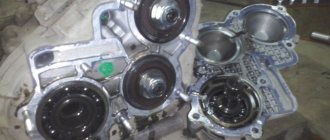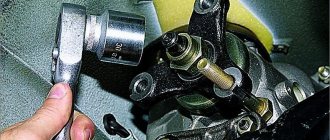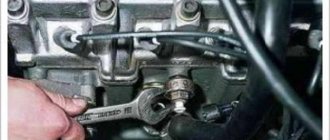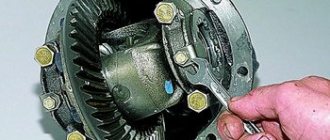Cars admin26.02.2020
*For vehicles with a fuel injection system with a catalytic converter and an oxygen concentration sensor. **Recommended application temperature range: 0W-30 below -35 o C...+25 o C 0W-40 below -35 o C...+30 o C 5W-30 -30 o C...+25 o C 5W-40 -30 o C...+35 o C 10W-30 -25 o C...+25 o C 10W-40 -25 o C...+35 o C 15W-40 -20 o C...+45 o C 20W-50 -15 o C ...above +45 o C ***Recommended application temperature range: 75W-80 -40 o C...+35 o C 75W-85 -40 o C...+35 o C 75W-90 -40 o C...+45 o C 80W-85 -26 o C...+35 o C 80W-90 -26 o C...+45 o C 85W-90 -12 o C...+45 o C and above
The text was scanned by Alex-Niva, processed by ALER, and supplemented by Katzyn.
Regarding the oil volume in the gearbox, the manual erroneously states 1.35 liters (in fact it should be 1.6 liters). It is recommended to fill 100-200 more grams (1.7. 1.8 l). To fill a larger volume of oil than the filler hole, the machine can be tilted to the right. Or you can simply “spit” excess oil into the filler hole, quickly plug it with your finger and screw on the plug.
Filling volumes for a VAZ 21214 car
It’s one thing to buy a car, and another to know and understand what to do with it: what to protect it from, when to “feed” it, how to operate it.
No matter what kind of car you own, sooner or later you will need to refuel it. Today we will talk about the filling volumes of the VAZ 21214 and what to fill where. First of all, let's talk about the fuel tank. Its volume in the VAZ 21214 is 42 liters (including reserve). Fill with gasoline with an octane rating of 91 to 93.
The fuel supply system is necessary to power the car engine, as well as its cleaning and storage.
The volume of the cooling system is 10.7 liters, which also includes the interior heating system. Fill in coolant whose freezing point is not higher than minus 40°C.
Cooling system - devices that provide supply of cooling medium to heated engine parts and removal of excess heat, i.e. maintaining the engine within the required thermal limits.
Engine lubrication system - 3.75 liters. It is necessary to select a specific oil, depending on the ambient temperature.
Temperature Oil
-20°С +40°С SAE 15W-40
-25°С +45°С SAE 10W-40
-30°С +45°С SAE 5W-40
-25°С +35°С SAE 10W-30
-30°С +35°С SAE 5W-30
The main task of the lubrication system is to reduce friction of mating parts. It also provides cooling of engine parts, protection against corrosion, removal of wear products and carbon deposits.
The filling volume of the gearbox housing is 1.35 liters, the transfer case housing is 0.75 liters, and the front axle housing is 1.15 liters. and rear axle housing 1.3 l. To fill these units, gear oils with a quality level corresponding to API GL-5 and a viscosity of 75W-90 are suitable.
The steering gear housing has a volume of 0.18 liters. You can add 75W-90 gear oil here.
The hydraulic brake system (0.515 liters) and clutch release system (0.2 liters) will require DOT-4, -3 brake fluid, respectively.
The volume of the windshield washer and rear door glass washer reservoir is 2 liters. You can fill it with either regular water or a mixture of water and windshield washer.
https://youtube.com/watch?v=M4OqWDFaqHM
Other liquids and fuels and lubricants
Every car enthusiast should know by heart the maximum fuel capacity of his car. The fuel tank of the VAZ 21213 has a capacity of 42 liters, including reserve. The reserve refers to the amount of fuel remaining in the tank after the yellow warning light on the instrument panel turns on. The reserve amount is at least 5 liters. The car must be fueled with gasoline whose octane number is in the range of 91-93.
The car has a number of refueling tanks that the owner must monitor during operation:
- brake system with expansion tank, total capacity - 0.515 l;
- hydraulic clutch drive with expansion tank - 0.2 l;
- 2 plastic tanks with a volume of 2 liters each contain a supply of windshield and rear window washer fluid.
The clutch release drive and brake system are filled with hydraulic brake fluid (the most popular is DOT-4). It should be changed at least every 3 years, because the liquid has the ability to absorb water vapor contained in the air. As a result, all steel parts of the system in contact with it begin to corrode, which leads to complete or partial failure of the brakes.
If there is a leak in the clutch or brake system, the level in the expansion tanks decreases, so constant monitoring is required over them.
The level of brake fluid in the reservoirs must be maintained no lower than the corresponding mark on the plastic body of the container.
Liquid or clean water for washing glass is added if necessary; in winter, a non-freezing option is required. Otherwise, the ice will not only destroy the tubes, but also damage the electric pump.
Various thick lubricants are also used for maintenance and lubrication of the Niva:
- Litol - a composition for lubricating highly loaded bearing parts;
- CV joints-4 - lubricant for the hinges of the front axle shafts and door opening limiters;
- ShRB-4 is designed for processing ball joints and steering rods.
The list of refueling containers is useful for novice car enthusiasts who bought a used car with a lost instruction manual. The operation of such a car should begin with the replacement of all fluids and oils.
Replacing antifreeze is a standard procedure, and Niva 2121 is no exception. This liquid retains its original properties for up to 40,000 km or 2 years (for antifreeze) and up to 250,000 or 5-7 years (for other brands of antifreeze). The activities, with some exceptions, do not differ from similar actions on other machines.
Replacement instructions
Power steering kit for Lada Niva 4x4, 21213, 21214, 2131 and 2123 Chevrolet Niva (injector, carburetor)
The procedure for replacing the coolant is not complicated, so even a novice car enthusiast can perform it.
How much to pour?
Antifreeze in a car, according to the manufacturer’s recommendations, should be changed after 40 thousand kilometers or after two years of operation. In this case, it is necessary to constantly monitor the condition of the coolant and check its level. If it has darkened or become cinnamon in color, then it needs to be changed. If the level is below the required level, add water or antifreeze. Replacement may be required if the coolant poured into the car does not meet the density.
The required volume of liquid to be filled is 10 liters. It is advisable to fill with coolant specified in the owner's manual.
Coolant
What will you need?
To carry out the replacement, you will need an inspection hole, a lift or an overpass. The machine must be installed horizontally and secured so that it cannot roll during work. The front of the machine should be installed higher than the rear. The procedure is carried out only on a cold engine. To carry it out you need to prepare the following tools and materials:
- spanner set to “10”;
- pliers;
- screwdriver;
- funnel;
- container for draining waste liquid;
- new antifreeze;
- clean rag.
A watering can can be made from a plastic bottle by cutting it in half. A canister or plastic water bottle is suitable as a container.
Stages
Having installed the car on the inspection hole, they begin to replace the coolant.
- First, open and secure the hood.
- The next step is to unscrew the cap on the expansion tank.
It is advisable to perform the procedure on a cold machine. Expansion tank Niva Chevrolet If this is not possible, then the coolant temperature should be no higher than 90 degrees. To avoid getting burned by steam or hot liquid, place a rag on the engine and around the neck of the expansion tank. The lid should be unscrewed carefully. First you need to unscrew it a little so that hot air comes out and release the tank from pressure, and then unscrew it completely. - Now unscrew the plug on the drain hole and drain all the liquid. When the used antifreeze has drained, screw the plug back into place.
- To prevent the formation of air plugs in the cooling system, you need to disconnect the hose from the throttle body fitting. To do this, use a screwdriver or pliers to loosen the fastening on the clamp and move it back. Then disconnect the hose from the throttle assembly fitting.
- Before adding coolant, it should be prepared. There are ready-to-use liquids, mainly antifreeze. There are antifreezes that require dilution with distilled water; usually the proportion is 50/50, unless otherwise indicated in the instructions.
- Next, you can proceed to filling the cooling system.
Coolant is poured into the expansion tank. As soon as it begins to flow out of the throttle body nozzle, put the hose on the nozzle and tighten the hose clamp. Next, continue to fill the antifreeze solution to the maximum mark in the expansion tank. - When pouring antifreeze solution, tighten the radiator hoses to prevent air pockets from forming.
- After the cooling system is filled, tighten the cap on the expansion tank.
- Next, you need to start the engine and wait for the electric fan to turn on.
If this does not happen, you need to check what kind of air is coming from the heater. If it is warm, then the fan is faulty; if it is cold, the reason is the presence of air pockets formed in the system. To get rid of them, you need to open the cap on the radiator, start the engine, and after 5 minutes of operation, turn off the engine. Now close the radiator cap. Removing the radiator cap - When the second cooling circle opens, the coolant level will drop significantly.
- You must wait until the engine cools down. Next, check the fluid level again. On a cold engine it should be between maximum and minimum, on a hot engine it should be at maximum. If necessary, add to the required volume.
If we remember the old days, instead of the current modern coolants, such as antifreeze and antifreeze, they used to pour water even into the Niva. And accordingly, when cold weather set in, I had to constantly struggle with draining the coolant. Of course, now few people remember this, but according to veteran motorists, such times took place back in the distant USSR.
Nowadays, antifreeze needs to be replaced approximately once every two years or after 40,000 km, as some manufacturers of these coolants write. This procedure will be described in detail below and photographs of this work will be presented.
VAZ 2121 Niva fuel consumption per 100 km
VAZ 2121 Niva fuel consumption per 100 km Hot news
Home » Fuel consumption » VAZ 2121 Niva fuel consumption per 100 km
Real reviews from owners about fuel consumption on the VAZ 2121 Niva:
1.7 manual transmission petrol
- If you want, check it out for yourself, but I personally noted for myself that this is a very economical car. In the city on 92 gasoline it is only 11 liters per hundred. This indicator is valid in the absence of traffic jams. If there is snow outside and the temperature drops to 20 below zero, then in this case it may increase by 4 liters for the injection Niva 2121.
- For a device in the domestic automotive industry under the glorious name of the VAZ 2121, fuel consumption is very impressive - 13.5 liters in city traffic jams and 10 liters on a dry highway at a speed of no more than 100 km/h. I note that fuel consumption on the highway does not hurt your pocket. At least my wife is happy with the purchase, even though she doesn’t know much about cars.
- Every weekend I go to the dacha in the neighboring village in my injection Niva 2121. Half the way is in the city. Its fuel consumption is about 12 liters per 100 km, so I am pleased with my purchase. I think that off-road and in the city, the gas consumption of the Niva is the same.
Niva 2121 injector and its fuel consumption
- 14 liters per hundred kilometers in urban conditions - fuel consumption is low for the VAZ 2121. Even taking into account traffic jams and hour-long downtime, gasoline consumption is extremely low.
- The gluttonous development of domestic production was very disappointing. Just imagine - 13 liters of fuel consumption for the Niva 2121 is very high. The city will empty our pockets. As a result, it turns out that if the car continues to eat gasoline in buckets, it will not pay for itself soon, so here’s the injector.
- I am an experienced hunter. I like to climb into such wilds where game is not shot due to inaccessibility. I bought myself an injector Niva and was taken aback - it consumes up to 16 liters off-road. It's not a cheap pleasure. It’s sad if you can’t even shoot a bunny. The entire journey, taking into account fuel consumption, is quite expensive due to excessive gluttony (12 liters). I'm starting to regret it.
VAZ 21214 Niva, 5 years operating experience
1.7 manual transmission petrol
- The only disappointment with the purchase is the rather small fuel tank. I specifically checked the fuel consumption on the highway - up to 9 liters per 100 km, and I did not drop the speed below 100. It turns out that on long trips in a VAZ 2121, refueling is enough for 400 kilometers. My relatives live far away, and I often go out into nature. You will have to put an additional tank in the trunk; with these “refueling” parameters you can even go to America. I like to go fishing with my friends. Considering the fuel consumption on the highway, we spend very little.
- In fifth gear it consumes only 8 liters per hundred. I never drive above 100 km/h. It is in fuel consumption that the beauty of an injection engine is revealed. I am more than satisfied with the purchase. Many people complain about excessive gas consumption, but I sincerely do not understand them.
- Yes, our cars don’t know how to make: Gaps between parts of the car, rapid wear of components. The engine capacity is small, but the car's appetite is too great for the carburetor version. Just think - 14 liters of fuel consumption in the city. What kind of consumption can there be in winter then?
Fuel consumption on Niva 2121 carburetor
- 14-liter fuel consumption on the highway is the height of indecency for a VAZ 2121. You can argue with me, of course, but I’m confident in the numbers. You won't go far with that kind of fuel consumption. Only now I realized that I should have used an injector instead of a carburetor...
- The mixed cycle consumes 12 liters. Dissatisfied. Until I drove 2,000 km, the car’s fuel consumption was generally 14.5 liters. “Niva’s” appetite is indescribable.
- It’s winter outside and you can save up money for the next repair, but with my “mutant” this is impossible. It spends 22 liters when driving through a snowy city. So you can become bankrupt. And with mileage, fuel consumption will only increase, I think. In general, I do not recommend taking the carburetor version. What fuel consumption is considered normal for Niva 2121? Who knows?
- If you believe the passport data, in the city the fuel consumption of a car should be strictly 12 liters per 100 km. But who will believe this data? What's the point of them? I checked. Its gluttony indicator exceeds the indicated one by as much as 2 liters.
We recommend viewing
← Previous article Next article →
22 Comments on VAZ 2121 Niva fuel consumption per 100 km
avtozal.net
Oil selection
Refill tanks for VAZ 21214 Niva injector
Selecting oil for Niva 21214 is not so difficult. But here you need to know some nuances in order to avoid common mistakes. Let's start with the time of year. Not every car owner knows what kind of oil to pour into the engine of his Niva if it’s summer or winter outside. In summer the weather is hot, so passenger car engines get very hot under such conditions. “Niva 21214” is an all-wheel drive SUV, and its engine warms up even more. That’s why many people make the same mistake, filling in mineral or semi-synthetic oil for the summer. To ensure that the engine runs efficiently and does not overheat, experts recommend using high-quality synthetics.
If the lubricating fluid in the power unit has an insignificant percentage of viscosity, you should not expect the expected effect from it. When the cylinder block heats up, such oils have a consistency similar to ordinary water and their temperature rises rapidly. Therefore, the lubricant will no longer take heat from the engine, performing a cooling function, and will also not be able to create the required pressure. Operating in this mode will lead to rapid jamming of the crankshaft.
Therefore, the manufacturer and experienced car owners themselves advise filling the Niva engine, as well as the Chevy Niva (Chevrolet) engines, with motor oils with a viscosity of 20W40, but not higher than 25W50. These are the optimal viscosity parameters at which the crankshaft can function normally and not create unnecessary load. This way the Niva engine will not heat up above its required operating temperature of 95 degrees Celsius. Now to the question of what kind of oil to pour into the Niva for the winter. The manufacturer emphasizes that winter oils must have certain characteristics. They should not be:
- very liquid (otherwise an ice film will form from the cold);
- too thick (otherwise the crankshaft will not be able to rotate when starting a cold engine).
For winter, it is better to fill the engine with oil that meets the viscosity parameters of at least 0W40 and maximum 0W50. By pouring such liquid into the engine in winter, when the temperature drops to a maximum of -40 degrees, the starter can easily cope with cranking. The viscosity is not very high, and even low temperatures will not prevent the engine from starting. Knowing which oil is best to pour at different periods, you will be able to maintain optimal operation of the power unit. But Niva has its own pitfalls regarding the lubricant composition. The oil poured into the engine must be seasonal.
Avoid semi-synthetic oils. Yes, such mixtures can be expensive and have similar characteristics to synthetics. But even the high price and identical labels on the packaging do not allow semi-synthetics to obtain the same properties that synthetic oils have.
Manufacturers
In terms of choosing manufacturers, each Niva 21214 owner decides for himself how expensive or budget oil to use. The market has formed its own leaders, who offer high-quality compounds for almost any car, including the all-wheel drive SUV we are considering today. But their only problem may be their high cost. If there is such an opportunity, then the Niva 21214 engine should be filled with oils from the following manufacturers:
- Shell;
- Mobil;
- Xado;
- Lukoil.
If you want to use something more affordable, but without risking the quality and performance of engine lubricants, then pay attention to the following manufacturers:
- ZIC;
- Castrol;
- Valvoline;
- Kixx.
They are recommended by many experts because they work well in practice. The main thing is to choose those compositions for Niva 21214 that meet the physical and chemical specifications necessary for its power unit.
Churches and Temples
Church of St. Nicholas the Wonderworker - St. Nicholas Church
Technical characteristics and dimensions of Niva 21213; 21214; 2131. Lada 212140 technical specifications. technical characteristics of Lada 212140
The Church of St. Nicholas the Wonderworker today is called the Church of St. Nicholas, or St. Nicholas Church. Erected as a church in 1777 in memory of the victory of the Russian fleet over the Turkish squadron. Rear Admiral Fyodor Alekseevich Klokachev petitioned for its construction.
The church was erected on Cape Tagan-Rog, at the location of the camp tent of Peter the Great, who came here to decide on the construction of a fortress and port. The parishioners of the church were outstanding famous people: Admiral Fyodor Ushakov (during the service), writer Anton Chekhov.
The church buildings were restored in the 1990s and opened as St. Nicholas Church.
Church of the Nativity of the Blessed Virgin Mary
The Orthodox Nativity Church was founded in 1943. The building for it was purchased by Abbot Salafiel, who arrived from the territory of Ukraine during the German occupation, in 1941.
A house was purchased on the street, which became a prayer house for the Orthodox. Services began after the liberation of the city, in 1943. The abbot himself was repressed in 1953.
Today, a medical education center has been opened in the church.
Cell of St. Paul of Taganrog
Address: per. Turgenevsky, 82 Website of the Rostov-on-Don Diocese: https://pravtaganrog.ru/vsecerkovnoe-proslavlenie-svyatogo-pavla-taganrogskogo-voprosy-i-zadachi/ Opening hours: daily, May-September 8-00-19-00 , October-April 8-00-17-00
The house-cell is the habitat of Elder Pavel of Taganrog (1792-1879), canonized by the Russian Orthodox Church in 1999. Before settling in Taganrog, Pavel wandered around Russia for 10 years, setting his serfs free. After settling in Taganrog, he hid his noble origins and received novices in a house-cell.
The relics of the canonized saint are kept in the St. Nicholas Church in Taganrog.
Next to the house-cell there is a well, consecrated by John of Kronstadt. Saint Paul filled the well with water from various holy springs of Rus'.
Transmission
Dimensions of Niva Chevrolet. Chevrolet Niva dimensions, dimensions, volumes, Chevrolet Niva 4x4 ground clearance, trunk
Replacing lubricant in machine engines is a simple procedure that you can perform yourself, without the help of specialists. The main thing in this matter is to know what kind of oil and where to fill it.
If we talk about the VAZ 4x4 2121 Niva, then the engine should contain approximately 3.75 liters of oil product. Moreover, you need to fill in one brand of oil; different types cannot be mixed. Otherwise, the entire proportion will be ruined.
When mixing a mineral and a synthetic sample, the result will be a substance of low quality. It forms pieces that are not acceptable for the normal operation of the unit.
Replacing lubricating fluids is provided not only for the engine, but also for other components of the VAZ 4×4 2121 Niva. Places, filling volumes, names of oils are given in the table.
Page 68
The Niva 4x4 transmission system has the following filling volumes:
- transfer case - 0.79 l;
- gearbox - 1.6 l;
- rear axle - gearbox - 1.3 l;
- front axle - crankcase - 1.15 l;
- steering column - crankcase - 0.18-0.2 l.
| Lower limit of ambient temperature, °C | -15 | -25 | -25 | -30 | -40 |
| Upper limit of ambient temperature, °C | 45 | 45 | 35 | 45 | 35 |
| SAE lubricant viscosity grade | 85W-90 | 80W-90 | 80W-85 | 75W-90 | 75W-80 75W-85 |
As stated in the operating instructions, transmission lubricants need to be changed once every 30 thousand km. mileage At the same time, replacement is not provided for in the steering mechanism housing, only an addition through the top plug. The “native” oil for Zhiguli transmission units is considered to be TAD17I.
Transmission oils have good penetrating ability. Therefore, poorly clamped plugs and worn gaskets of units begin to gradually leak lubricant. In such situations, it is allowed to add oil of the same viscosity class and, preferably, the same manufacturer. If you do not top up during a leak, the lubricant level in the unit will decrease, which will lead to accelerated wear of expensive mechanisms.
Malfunctions of VAZ transfer cases
The transfer case is not present in all VAZ passenger cars, but only on cars with two drive axles. In the transmission, the transfer case (TC) is installed at the rear of the gearbox; a rear driveshaft is attached to its shank, which connects the transfer case to the rear axle. The front axle is also driven by the steering wheel; it is connected to the transfer case by a front driveshaft.
The reduction gear in the Republic of Kazakhstan is designed to obtain high torque, it is used to overcome difficult sections of the road, and helps to cope with off-road conditions. The VAZ Niva transfer case contains the following main parts:
- the body itself;
- front axle drive shaft;
- intermediate shaft;
- drive shaft;
- gears;
- bearings;
- differential housing;
- satellites;
- differential lock clutch;
- gear shift clutch;
- flanges (for connection to cardan shafts);
- oil seals;
- control levers.
The transfer case on the Niva is a fairly reliable unit; problems with repairs in the mechanism itself arise mainly due to insufficient oil level in the valve - if for some reason the oil leaks out, intensive wear of all parts occurs. Among the frequently occurring malfunctions are:
- vibration in the body at various speeds when the car is moving;
- vibration when the vehicle starts moving;
- noise in the transfer case when the car is slipping or turning;
- difficult upshift or downshift, difficult engagement of the lock.
- the body itself;
- front axle drive shaft;
- intermediate shaft;
- drive shaft;
- gears;
- bearings;
- differential housing;
- satellites;
- differential lock clutch;
- gear shift clutch;
- flanges (for connection to cardan shafts);
- oil seals;
- control levers.
A violation of the normal operation of the VAZ-21213 transfer case can be assumed by the following signs:
- Delays when connecting front-wheel drive.
- Transfer case overheating.
- High transmission oil consumption.
- Spontaneous disconnection of the front axle.
Procedure:
- Remove the cover, which is located on the floor tunnel where the switching elements are installed. To do this, unscrew the 4 screws.
- Unscrew the 3 self-tapping screws designed to secure the trim under the arms. Pull out the levers and remove the trim along with them. Disconnect the wires that appear in the special hole.
- Disconnect the driveshaft from the transfer case. To do this, you can use a 13mm wrench. Unscrew the special locking nut and pull out the speedometer cable.
- Disconnect the gearbox drive shaft from the transfer case. Thus, we exempt her from the checkpoint. Remove the transfer case by unscrewing the nuts of the special suspension device.
- Install the new unit in reverse assembly sequence.
This completes the replacement and repair of the Niva transfer case. As you can see, this is not a complicated operation and is performed on your own in the conditions of an ordinary garage. Thus, you can save a lot of money on the services of car service specialists.
Changing the oil of the front gearbox Niva VAZ 21213, 21214, 2131 lada 4×4
(see also Changing the oil in the rear gearbox)
How often do you change the oil in the front axle gearbox? - The oil in the rear axle gearbox needs to be changed every 40 thousand km, and on a new car the first change is done after 2 thousand km. mileage, and then every 40 thousand km.
How much oil should be poured into the front axle gearbox? - 1.15 liters.
What kind of oil should be poured into the front gearbox? - Gear oil of API GL-5 quality and viscosity 75W-90
(for more details about specific brands and characteristics of oil, see Liquids used and filling volumes)
How to check the oil level in the front gearbox? - The oil level is measured on a cold gearbox. On a pit or overpass, remove the engine protective shields. Using a 17" wrench, unscrew the filler plug of the gearbox.
The oil level should reach the lower edge, which can be checked with your finger. If the level is significantly lower, add oil with a syringe in the same way as shown below (when replacing) until the oil begins to flow out. After draining the excess oil, tighten the plug.
Replacement
| We carry out the work on an inspection ditch or a lift. Before changing the oil, you need to warm it up by driving the car for at least 10 km so that the oil warms up properly and becomes fluid. |
Remove the engine dust shield.
| Use a 12mm hex to unscrew the drain plug... |
| ... and drain the oil into a substitute container. |
We clean the magnet of the drain plug and wrap it.
| Using a 17mm spanner, unscrew the filler plug. |
| Using a syringe, fill in new oil to the required level (see the beginning of the article) |
We wrap the filler plug.
| We clean the breather... |
...located on the right side of the gearbox housing.
Brake fluid Niva Chevrolet, gourmet
In 2021, I began to work very closely with the trendsetter in brakes, the Italian concern Brembo. I was sent a dealer catalog and in the service section I found brake fluid. The jar contains the company logo, the inscription “made in Italy”, and product characteristics. A technician confirmed that this product is made in-house. The price is a little more expensive than competitors, but it's worth it. Kinematic viscosity (pumpability) at minus 40 is 1400 cCt (DOT-4 – 1800), which allows it to be classified as DOT-4+ and used in cold climates.
Oil change intervals on Niva
The service life of the motor largely depends on proper maintenance. Compliance with lubricant change intervals is also of great importance. The frequency of the procedure largely depends on the condition of the vehicle, its operating conditions, and directly on the lubricant itself. The manufacturer recommends changing every 20 thousand km (or every twelve months). However, these figures are averages and do not take into account many aspects.
What affects the timing of the lubricant change procedure:
- Air pollution.
- The quality of the fuel being poured.
- Changes in temperature values.
- Condition of the roads.
- Travel mode. In traffic jams, the mileage does not increase, but the engine runs.
Depending on how the car is used, the need for periodic topping up of oil cannot be ruled out. This is due to the natural consumption of lubricant during operation of the power unit. It can reach up to 0.7 liters every 1000 km. High fluid consumption is one of the disadvantages of the engine of this vehicle (along with low service life, noisy operation of the unit and vibrations).
Despite the information provided by the manufacturer, the actual lubricant replacement interval is 7...10 thousand km, which is due to the engine operating under fairly significant loads.
An important aspect when preparing for a replacement is that it is important to choose correctly which oil for the Niva engine will be the best option. Any car owner must take this task responsibly if there is no desire to carry out unplanned repair work
Leaks and problems
The higher the mileage of the VAZ Niva, the more problems appear, as in principle with any car. Most often this is due to natural wear and tear of the engine, causing oil to burn. Although the manufacturer allows for a small consumption.
If the breather is spewing or throwing oil, or if there is oil in the exhaust manifold, this may indicate a serious problem with the oil rings. In this case, you can try decoking with dimexide. But it is better to use special auto chemicals designed for these purposes.
A leak from under the valve cover may be due to a worn gasket. Sometimes simply replacing the gasket does not solve the problem. Since the cover itself may have significant curvature. Therefore, in some cases it will have to be replaced.
A white emulsion in the engine or on the oil filler cap may indicate condensation. This is a common occurrence when temperatures change from minus to plus, mainly in autumn or spring.
But if the emulsion is also observed on the dipstick, then this is already a sign of more serious problems. Most often we can talk about a broken cylinder block gasket. And in rare cases, a cracked cylinder head may be to blame.
Also, with this problem, you can find oil in the expansion tank. Sometimes, simply replacing the gasket is not enough. It may be necessary to grind the head itself, and this is completely different money for repairs.
All this is general information, which may manifest itself differently on each specific vehicle, since everyone’s operating modes are different. The same applies to leak locations; it is impossible to identify the cause from a distance.
Tightening torques for gazelle threaded connections
There are only 10 bolts on the cylinder head of Gazelle engines. Their caps have a diameter of 14 mm. After all the bolts have been tightened, you need to go through them again to make sure that they are all tightened as needed.
On ZMZ 406 and 405 models, pulling the bolts of the device is carried out in the following steps:
- Stage one. The parts of the device are pulled using a torque wrench with a force of 40-60 Nm.
Stage two. The threaded parts of the device are pulled with a force of 127 - 142 Nm.
Power unit
The engine installed on the modern model of the Niva 21213 (214) car was inherited from its Soviet progenitor - the VAZ 2121, and in terms of fluid volumes they are almost identical:
- Liquid cooling system. Filled with antifreeze in an amount of 10.7 liters with a freezing point not higher than -40 ° C. The capacity of the interior heating radiator is also included in this volume.
- Crankcase. Motor oils are poured here, the brand of which depends on the operating conditions. Capacity: 3.75 liters, including oil filter filling.
The viscosity of the oil poured into the Niva engine must correspond to the outdoor temperature at which the car is operated. Possible modes and suitable oil brands are shown in the table:
When flushing the power unit during the process of replacing liquid lubricant, the same amount of flushing oil (3.75 l) is used, taking into account the size of the filter. Replacement is carried out after 8-12 thousand kilometers, depending on the quality of the oil. Flushing is usually performed after 3 engine lubricant changes. During operation, it is important to monitor the oil level in the engine crankcase using a special dipstick. If the level drops below the Min mark, it is urgent to add lubricant to the engine of the same viscosity as was previously filled.
Antifreeze needs to be updated at least once every 3 years or according to the degree of wear of the fluid. It is not recommended to dilute antifreeze with distilled water, either in winter or summer. In winter, the diluted liquid may freeze, and during the summer heat it may boil ahead of time, which will lead to overheating of the engine.
Why is tire pressure monitoring important?
Some drivers do not attach much importance to the level of pressure in the wheels. This is an unforgivable mistake that ends in a number of unpleasant consequences for the wallet of the unlucky car owner. It may seem like a small thing, but tire pressure has an impact on the safety and efficiency of driving.
There are 3 main states of the wheel:
1.Underinflated wheel.
A characteristic sign of a chronic lack of air in a tire is uneven tread wear. In this case, the middle part experiences a lower level of friction and the side areas of the wheel wear out quickly.
2.Inflated tire.
Optimal air level in the tire promotes even tread wear. The contact area between the wheel and the road surface is maximum.
3. Overinflated wheel.
Maximum tread wear occurs in the middle part. The sides practically do not come into contact with the road surface.
Lack or excess pressure in a tire leads to premature tread wear and reduced vehicle controllability.
Many drivers, due to lack of time or laziness, do not properly control the parameter. Often different levels of air pressure can be found in all 4 wheels.
The system for informing about the current state of tire pressure, which is installed in modern cars, is not capable of solving problems
Many drivers pay attention to indicators when the air pressure in the tire approaches zero.
Harmful consequences of using a tire with incorrect air pressure:
- Uneven wear.
- Reducing the service life by 3 times.
- Increased braking distance.
- Reduced controllability.
- Reduced level of adhesion to the road surface.
- Increased fuel consumption.
- The likelihood of damage increases by 2 times.
More information about tires and wheels can be found on the website https://wheel-info.ru/, which contains a lot of useful and interesting information.
Tips and summary
This class of car is intended mainly for off-road driving. This is characterized by its connection of the box to all-wheel drive. The car behaves well in overcoming various off-road obstacles in various weather operating conditions. These factors greatly influence the transmission design as a whole. To maintain the reliability and efficiency of the transmission, it is necessary to take a responsible approach to the choice of oil. The quality of the gearbox directly depends on the quality of the selected oil. Only the correct grade of oil should be used. If you fill in oil with a lower class, loads expressed in temperature changes or overcoming serious off-road conditions can damage the transmission.
To prevent this, you should carefully follow the following recommendations:
- it is necessary to study all operating instructions provided by the car manufacturer;
- do not chase the price of lubricants. For the most part, the high price of oil does not depend on its high quality. This often happens due to brand recognition. The more popular it is, the higher the price of the product provided;
- Follow the rules and terms for changing the oil. This will extend the life of the box and make the ride more comfortable;
- If the car was purchased secondhand, it already has a high mileage. You need to pay attention to this and change the oil more often than usual;
- It is necessary to frequently monitor the oil level, checking it a couple of times a week, to prevent its level from dropping, which can cause serious problems with the transmission.
The gearbox design in the domestic Chevrolet Niva car does not have any complex technical details. The car has proven itself to be good in terms of performance and transmission quality. There are no complaints about the cost and timing of the service. By carrying out the required repairs and replacement of consumables according to the regulations, the car will last a long time and will bring driving pleasure to its owner.
Characteristics of motor 21214
For any vehicle, the importance of timely replacement of lubricants cannot be overestimated. Oils used in components and assemblies subject to friction at high speeds significantly reduce their overheating and wear, helping to extend their service life. Among such components, one cannot fail to note the transfer case, which is equipped with all-wheel drive vehicles.
Among such components, one cannot fail to note the transfer case, which is equipped with all-wheel drive vehicles.
note
Both old Niva cars and models under the Chevrolet brand, produced since 2002, need no introduction - these are one of the most popular all-wheel drive vehicles in our country, which have earned the love of motorists for their unpretentiousness, ease of maintenance and low cost.
What is especially pleasing is that the vast majority of maintenance operations on a domestic SUV can be performed independently, without turning to the help of specialists or a car service center. In particular, this also applies to changing the oil in the Niva transfer case - a procedure that does not require special professional skills or special tools.
The oil in the Niva transfer case should be checked every 10 thousand km.
Filling with oil
Many car owners are faced with the task of having to perform maintenance on their car.
At the same time, some perform the maintenance with their own hands and enjoy the repairs, and at the same time save their money, some prefer to spend money (so as not to get dirty and mess around) and take the car to a car service center, blindly trusting their iron horse to strangers.
And, by the way, changing the oil of the VAZ 21213, as in other models, is a responsible process and the service life of all components of the car directly depends on its correct and timely implementation! The replacement process is simply elementary, it doesn’t take much time, and anyone can do it themselves.
07.12.2017
The Niva 21214 car is distinguished by its increased cross-country ability on roads. The car has an engine that has a volume of 1.7 liters, which complies with Euro-4 standards.
The transmission system includes a transfer case with a crankcase ventilation system. All components on the VAZ 21214, just like on the VAZ 21213, are characterized by a long service life.
It is important to take proper care of the automotive system and select high-quality oil for the Niva. The Niva SUV (VAZ 2121), which has all-wheel drive and is equipped with a manual transmission, is capable of producing 75 horsepower. The Niva SUV (VAZ 2121), which has all-wheel drive and is equipped with a manual transmission, is capable of producing 75 horsepower
The Niva SUV (VAZ 2121), which has all-wheel drive and is equipped with a manual transmission, is capable of producing 75 horsepower.
Motor 21214 was used to equip several cars manufactured by AvtoVAZ:
- Lada Niva 4x4 (VAZ-21214) – three-door SUV;
- Lada 4x4 M - modernized version with power steering and ABS;
- Lada 4x4 5D (VAZ-213100) – an extended modification of a five-door SUV;
- “Ambulance” (VAZ-213145) – Euro-2/3 in small series;
- Lada Nadezhda (VAZ-2120) is a seven-seater all-wheel drive minivan.
Works
Then do the following sequence of actions:
Prepare an empty container, then use a nineteen hex key to unscrew the drain plug of the transfer case housing and drain the oil. Be careful when working as the oil is hot. The drain plug has a magnet to collect metal shavings and other debris, clean it, then screw the plug back into place.
Now, using a twelve-point hex wrench, unscrew the transfer case filler plug and use a technical syringe to fill it with new transmission oil.
Oil must be added to a level where it matches the lower edge of the filler neck.
Then tighten the plug. And at the final step, you need to clean the breather, which is located on the side of the rear propeller shaft.
Changing the oil in the Renault Duster transfer case
Changing the oil in the axle
What and how much oil to fill in the axle and transfer case of Duster 4x4
According to the manufacturer, the oil in the transfer case and axle cannot be replaced and is refilled for the entire service life of the vehicle.
But underfilling the transfer case and axle with oil is a fairly common occurrence on Renault Duster. In this case, it was only 2 cm short of the level, it’s not a big deal, but I had to change it to calm things down.
Since it is not clear what kind of oil was poured in, I had to play it safe and buy a new transmission oil, Total Syn Fe 75W-90, an oil recommended by Renault, which hardens at temperatures below 50 degrees.
To change the oil in the transfer case and axle of a Renault Duster, 1 liter is enough.
In this report, it took 1 liter and 50-100 grams, this is when filling to the maximum, to the level of the drain holes and taking into account the complete draining and washing of the rear gearbox and transfer case.
- We start with the rear gearbox
- You don’t have to lift the car; if you lie on the ground, there is enough space.
- Use a hexagon to unscrew the drain plug (bottom)
- Drain the oil, the oil will be quite black, this is normal.
- Screw the plug back in, don’t forget about the gasket
The oil will not all drain out, so you can use a vacuum hose to completely drain the oil.
The hose is a vacuum hose, because the walls do not compress. We insert one end of the hose into the filler hole of the gearbox, resting the hose against the bottom, the other end of the hose to the vacuum pump (or create a vacuum with our lungs), take the hose long so that oil does not get into the pump or be swallowed.
You can also wash the gearbox and drain the flushing fluid completely using this method. The oil drains well from the transfer case; there is no need to rinse it.
It is convenient to pour oil into the rear gearbox using this device
We insert the hose and pour new oil into the filler hole (upper), oil must be filled to the very edge of the hole.
We tighten the top plug on the gearbox and wipe off any traces of oil with a rag after replacement.
Let's move on to the transfer case
We remove the right front wheel (passenger side), you can simply turn it out if it is convenient.
The transfer case is located on the passenger side directly behind the wheel. See photo below.
We find the filler hole, which is also the control hole.
Transfer case oil level was normal.
To access the drain plug, you will have to partially remove the protection by unscrewing the six fastening bolts so that the protection hangs only on the front ones. The transfer case drain plug is indicated by an arrow.
The oil drains well from the transfer case; there is no need to rinse it.
Drain the oil and tighten the drain plug. We assemble the protection in reverse order.
The oil was poured everywhere exactly along the edge of the filler hole (it even spilled out a little).
The control and filler hole of the box is located in the same way as the dispensing hole, but on the left side.
The oil in the box was not changed, only the level was checked - almost level with the edge.
Material provided by: Dmitry (Kaluga)
Since the transfer case contains rubbing elements, wear products inevitably appear in it over time. If you do not change the oil in the transfer case in a timely manner, its service life will be reduced. The oil loses performance and fine particles increase gear wear.
VAZ-21214 engine modifications
| 21214-41 | modification with a power steering pump, with a welded steel manifold, YAZTA hydraulic supports, Euro 3. |
| 21214-34 | modification without power steering pump, with cast iron manifold, INA hydraulic mounts, Euro 3. |
| 21214-33 | modification with power steering pump, cast iron manifold, INA hydraulic mounts, Euro 3. |
| 21214-32 | modification with power steering pump, cast iron manifold, INA hydraulic mounts, fuel pipes for quick connectors, flywheel for clutch 215mm, Euro 3. |
| 21214-31 | modification with power steering pump, steel welded manifold, INA hydraulic supports, Euro 4. |
| 21214-30 | modification without power steering pump, with welded steel manifold, INA hydraulic supports, Euro 4. |
Photo of the VAZ-2121 engine
Interior of Niva 2131
The interior of the car is simple but functional. The instrument panel with analog scales and tachometer is quite informative and easy to read due to large digitization. The climate system unit, light control keys and rear window heating are located on the center console. These elements are organized compactly, and there are no problems with their use.
The main advantage of the Lada Niva 2131 4x4 is its spacious interior. The front seats do not have a profile, but optimal rigidity and the presence of lateral support bolsters provide sufficient comfort. The cars are equipped with original convertible rear seats, which allow, if necessary, to increase the luggage compartment area.
The flat floor and wide opening facilitate the transportation of large cargo. The spare wheel is located under the hood, which allows for maximum usable space. The modernization of this car has led to the introduction of air conditioning and electric windows in luxury trim levels.
Changing the rear gear oil of Niva VAZ 21213, 21214, 2131 lada 4×4
(see also Changing the oil in the front gearbox)
How often do you change the oil in the rear gearbox? - According to the service book regulations, the oil in the gearbox is changed every 40 thousand km. If the car is new, then the first replacement should be after 2 thousand km, and then every 40 thousand km.
How much oil should I pour into the rear gearbox? - 1.3 liters.
What kind of oil to fill? - Gear oil of API GL-5 quality and viscosity 75W-90
(for more details about specific brands and characteristics of oil, see Liquids used and filling volumes)
Checking the oil level
You need to check the oil level every 10,000 km. on a cold gearbox.
Using a spanner wrench, unscrew the filler plug. The oil level should reach the bottom edge of the filler hole, which can be checked with your finger. If there is insufficient oil, add it as shown below until it starts to leak. After draining the excess, screw the plug back into place.
Change of oil
| We carry out the work on an inspection ditch or a lift. Before changing the oil, you need to warm it up by driving the car for at least 10 km. |
| Use a 12mm hex to unscrew the drain plug... |
| ... and drain the oil into a substitute container. (prepare a container of at least 1.5 liters) |
We clean the magnet of the drain plug and wrap it.
| Using a 17mm spanner, unscrew the filler plug. |
| Using a syringe, fill in new oil to the level of the lower edge of the filler hole. |
We wrap the filler plug.
| Using the key “13” we turn off the breather. |
We clean the breather and wrap it in place.
How to change oil in Chevrolet Niva axles
Niva 2121, Niva 2131 and Chevrolet Niva. let's compare?
To change the oil in Chevrolet Niva axles, you must follow the rules for maintenance and repair of this vehicle.
It is recommended to update fluids in bridges after three years of vehicle operation or in the range of 35-40 thousand km. Under severe operating conditions, this procedure must be performed several thousand kilometers earlier.
Preparatory work
The conditions for performing procedures for updating the oil in Chevrolet Niva axles do not differ from those for the transfer case. In both cases, an inspection hole or lifting of the car is required
The filler hole in the gearboxes serves as a level indicator, which is why it is so important to install our vehicle on a flat surface before starting work.
You need to fill the fluid as much as the amount of transmission oil that is poured into a Chevrolet Niva.
Warm up the car in advance. Clean the location of the drain plug. Prepare the necessary tools - a 12-size hex key and a 17-size socket with a wrench. In addition, you will need a container for used oil, rags and a refill syringe.
Change of oil
The procedures for changing the oil for the rear and front axles of a Chevrolet Niva are similar and are carried out in the following sequence:
- Unscrew the oil drain plug.
- Be sure to evaluate the bolt magnet for chip adhesion. If everything is normal, tighten the bolt into place.
- Through the drain hole, pour the used composition into a container.
- Screw in and tighten (rear axle only) the drain plug.
- Unscrew the filler plug.
- After all these steps, use a filling syringe to fill the required volume of fresh technical oil through the open filler hole.
- Screw in and tighten (rear axle only) the filler plug.
Motor oils
| Oil brand | SAE viscosity grade | Group | Manufacturer | Regulatory document | |
| AAI | AP1 | ||||
| LUKOIL LUX | 5W-30, 5W-40 10W-40,15W-40 | B5/D3 | SJ/CF | LLC "Lukoil-Permnefteorg-sintez", Perm | STO 00044434-003 |
| LUKOIL LUX | 0W-40, 5W-20, 5W-30, 5W-50, 10W-30 | B5/D3 | SL/CF | LLC "Lukoil-Permnefteorg-sintez", Perm | STO 00044434-003 |
| TNK SUPER | 5W-30, 5W-40 10W-40 | B5/D3 | SJ/SL/CF | TNK Lubricants LLC, Ryazan | TU 0253-008-44918199 |
| TNK MAGNUM | 5W-30, 5W-40 10W-40,15W-40 | B5/D3 | SJ/SL/CF | TNK Lubricants LLC, Ryazan | TU 0253-025-44918199 |
| ROSNEFT MAXIMUM | 5W-40, 10W-40 | B5/D3 | SL/CF | OJSC "Novokuibyshevsk Oil and Additives Plant", Novokuibyshevsk | TU 0253-063-48120848 |
| ROSNEFT OPTIMUM | 10W-30, 10W-40 15W-40 | B5/D3 | SJ/CF | OJSC "Novokuibyshevsk Oil and Additives Plant", Novokuibyshevsk | TU 0253-062-48120848 |
| ROSNEFT MAXIMUM | 5W-40, 10W-40 | B5/D3 | SL/CF | OJSC "Angarsk Petrochemical Company", Angarsk | TU 0253-391-05742746 |
| ROSNEFT OPTIMUM | 10W-30, 10W-40 15W-40 | B5/D3 | SJ/CF | OJSC "Angarsk Petrochemical Company", Angarsk | TU 0253-389-05742746 |
| ROSNEFT PREMIUM | 0W-40, 5W-40 5W-40 | B5/D3 | SJ/CF SL/CF SM/CF | OJSC "Angarsk Petrochemical Company", Angarsk | TU 0253-390-05742746 |
Continuation of the table. 2
| Oil brand | SAE viscosity grade | Group | Manufacturer | Regulatory document | |
| AAI | API | ||||
| EXTRA 1 EXTRA 5 EXTRA 7 | 5W-30 15W-40 20W-50 | B5/D3 | SJ/CF | OJSC "Omsk Oil Refinery", Omsk | TU 38.301-19-137 |
| EXTRA | 5W-30, 10W-40, 15W-40 | B5/D3 | SL/CF | OJSC "Omsk Oil Refinery", Omsk | TU 38.301-19-137 |
| ESSO ULTRA | 10W-40 | B5/D3 | SJ/SL/CF | Exxon-Mobil, Germany | |
| GTTURBO SM | 10W-40 | B5 | S.M. | Hanval INC, Korea | |
| LIQUI MOLY OPTIMAL | 10W-40 | B5/D3 | SL/CF | Liqui Moly GmbH, Germany | |
| MOBIL 1 MOBIL SYNT S MOBIL SUPER S | 0W-40, 5W-50 5W-40 10W-40 | B5/D3 | SJ/SL SM/CF SJ/SL/CF | Exxon-Mobil, Germany | |
| MOBIL 1 ESP FORMULA | 5W-30 | B6/D3 | SJ/SL SM/CF | ||
| RAVENOL HPS RAVENOL VSI RAVENOL LLO RAVENOL TSI RAVENOL Turbo-C HD-C | 5W-30 5W-40 10W-40 10W-40 15W-40 | B5/D3 | SL/CF SL/CF SL/CF SL/CF SJ/CF | Ravensberger Schmirstoffvertrieb GmbH, Germany | |
| SHELL HELIX: PLUS PLUS EXTRA ULTRA | 10W-40 5W-40 5W-40 | B5/D3 | SL/CF | SHELL EAST EUROPE Co, UK, Finland | |
| ZIC A PLUS | 5W-30, 10W-30, 10W-40 | B5 | SL | SK CORPORATION, Korea |
Note. The oil change period is in accordance with the vehicle service book.
RECOMMENDED TEMPERATURE RANGES FOR APPLICATION OF MOTOR OILS
Table 3
| Minimum engine cold start temperature, 0C | Viscosity grade according to SAE J 300 | Maximum ambient temperature, 0C |
| below -35 | 0W-30 | 25 |
| below -35 | 0W-40 | 30 |
| -30 | 5W-30 | 25 |
| -30 | 5W-40 | 35 |
| -25 | 10W-30 | 25 |
| -25 | 10W-40 | 35 |
| -20 | 15W-40 | 45 |
| -15 | 20W-40 | 45 |
Table 4
| Oil brand | SAE viscosity grade | API Group | Manufacturer | Regulatory document |
| LUKOIL TM 5 | 75W-90 80W-90 85W-90 | GL-5 | OJSC "Lukoil-Volgogradnefte-pererabotka", Volgograd LLC "Lukoil-Permnefteorgsintez", Perm | STO 00044434-009 TU 0253-044-00148599 |
| NOVOIL SUPERT | 80W-90 | GL-5 | OJSC Novo-Ufa Oil Refinery, Ufa | TU 38.301-04-13 |
| ROSNEFT KINETIC | 75W-90, 80W-90 85W-90 | GL-5 | OJSC "Angarsk Petrochemical Company", Angarsk | TU 0253-394-05742746 |
| ROSNEFT KINETIC | 75W-90 | GL-5 | OJSC "Novokuibyshevsk Oil and Additives Plant", Novokuibyshevsk | TU 0253-030-48120848 |
| SUPER T-2 SUPER T-3 | 80W-90 85W-90 | GL-5 | OJSC "Omsk Oil Refinery", Omsk | TU 38.301-19-62 |
| TNK TRANS GIPOID | 80W-90 85W-90 | GL-5 | TNK Lubricants LLC, Ryazan | TU 38.301-41-196 |
| TNK TRANS GIPOID SUPER | 75W-90 | GL-5 | TNK Lubricants LLC, Ryazan | TU 0253-014-44918199 |
| SHELL TRANSAXLE OIL | 75W-90 | GL-5/4 | Shell East Europe Co, UK |
Table 5
| Minimum temperature for ensuring lubrication of components, 0C | Viscosity grade according to SAE J 306 | Maximum ambient temperature, 0 C |
| -40 | 75W-80 | 35 |
| -40 | 75W-85 | 35 |
| -40 | 75W-90 | 45 |
| -26 | 80W-85 | 35 |
| -26 | 80W-90 | 45 |
| -12 | 85W-90 | 45 |
Attention Do not use oil additives or other means to improve the performance of the engine, its systems or vehicle transmission units. Modern high-performance motor and transmission oils are recommended for vehicle operation.
Therefore, there is no need to use additional additives, and in certain cases this can lead to damage to the engine or transmission units that are not covered by the AVTOVAZ OJSC warranty.
Modern high-performance motor and transmission oils are recommended for vehicle operation. Therefore, there is no need to use additional additives, and in certain cases this can lead to damage to the engine or transmission units that are not covered by the AVTOVAZ OJSC warranty.
Engine lubricant
So, the car owner needed to change the lubricant in the engine. An experienced one will use the one that has already been tested by him. What should an inexperienced car enthusiast do? There are two ways out - search on the Internet or ask knowledgeable drivers. Unfortunately, the opinions of many owners of this car differ greatly. This article will describe one type of motor oil - Shell 10W40. This semi-synthetic product is quite inexpensive, and the reviews about it are extremely positive. The car starts at very low temperatures. To approximately -28 °C. At -30 °C it is simply unreasonable to go anywhere in the field. Since not only oils freeze, but also the lubricating component of the engine can freeze. In principle, you can try Lukoil Lux. Semi-synthetic, almost identical to Shell. But it’s still worse, because many car enthusiasts do not recommend it. The reason lies in the fact that carbon deposits from Shell lubricant are much easier to remove. But for those who will drive Lukoil for a maximum of two or three months, the difference will be insignificant. By the way, it is also necessary to check the oil indicator on the dashboard in a timely manner. There are models of Niva vases that begin to consume this petroleum product excessively. And it has to be topped up every six months. To drain all waste from the engine, it must be warmed up before starting the procedure.
We constantly receive questions in the comments about what kind of “liquid glass” products this is, and in general what a bunch of auto-related advertising is now on the market. As a result, we decided to test in practice how true this is. Let's just say we used 3 means. One product proved to be so-so; after application, a burnt spot remained in this place. The second product, when applied, showed no effect at all.
The third product, SILANE GUARD, at first it was also felt that there would be no effect. but nevertheless, after the solution remained on the surface for several minutes, the effect was excellent. Of course, everything is not as beautiful as advertised.
We had a discussion at a local service station, they said that the products are effective, but they should be used only according to the instructions. And not as anyone pleases.
Methods for adding lubricant to a domestic vehicle engine
The reason for the ban on towing "automatic"
So, different types of automatic transmissions can be installed on cars. They differ from each other not only in design, but also in their operating principle. What they have in common is that when the engine is not running, the elements of the box remain without lubrication, since the oil pump only works in conjunction with the power unit. This is precisely the root reason why you cannot tow a car with an automatic transmission.
The fact is that, unlike a manual transmission, during towing, even with the engine not running, the entire automatic transmission mechanism continues to function. And since no lubricant is supplied, all its elements work “dry”. Increased friction is created between them, which threatens overheating and jamming, resulting in expensive repairs. That is why manufacturers of cars with automatic transmission strongly recommend abandoning towing with a hitch in favor of a tow truck. Moreover, for cars with all-wheel drive there is an additional restriction.
How to choose
Two types of fluid are poured into the transfer case: transmission oil or ATF fluid. On cars with an automatic transmission, ATF is usually filled into the transfer case, and on cars with a manual transmission, the transmission is filled. In this case, often the liquids must match or be completely compatible.
This is due to the fact that usually the connection between the transfer case and the gearbox is made by a single shaft, or one is attached to the body of the other. When mixing liquids, this will avoid the formation of emulsions, foaming and other side effects.
The viscosity characteristics of oils play an important role. Let's look at the meaning of the numbers using 80W90 oil as an example:
- 80 – viscosity at low temperatures
- W – all-season
- 90 – viscosity at high temperatures
If ATF is used, it is better to fill in the original fluid recommended by the manufacturer, or an analogue that has the appropriate approvals.
Advantages and disadvantages of a car
Niva 2131 has proven itself not only in Russia, but also abroad. Car owners have identified both positive and negative characteristics of this car.
| Body type | all-metal, monocoque, 5-door station wagon |
| Body class | SUV |
| Layout diagram | all-wheel drive, longitudinal engine |
| Number of places, people | 5, with the rear seat backs folded – 2 |
| Trunk volume, l | 420, with seats folded – 780 |
| Transmission type | 5MT |
| Wheelbase, mm | 2700 |
| Front/rear wheel track, mm | 1440/1420 |
| Front/rear brakes | Disc/drum |
| Advantages |
Flaws
In modern models of this SUV, anti-corrosion protection has become more effective, and the crosspieces in the cardan have been replaced with CV joints (constant velocity joints). The Lada Niva 2131 4x4 SUV is a legendary all-terrain vehicle that confidently overcomes off-road conditions. Differential all-wheel drive, front independent suspension, and the presence of a reduction gear are just some of the advantages of this car. The vehicle is perfect for both urban and rural areas.
